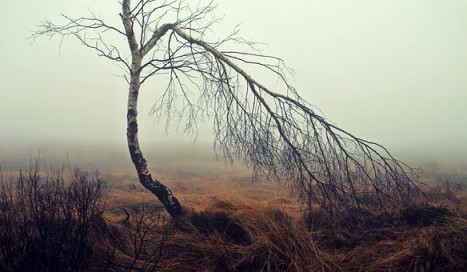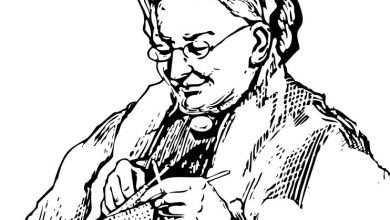
Birches : The poem
Birches is a wisdom-laden poem by Robert Frost which was a part of a collection titled Mountain Interval (1916). Written in blank verse and composed in a charmingly conversational tone, the poem revolves around the themes of the nature of Truth, the relation between fact and fiction, revisiting one’s childhood and the balance between life and art which must be maintained for a meaningful life. The poem describes the simple act of swinging the birch trees , a common sport among children in rural New England where Frost spent his childhood. The swinging of birches is used as a distraction, a passtime to busy oneself in order to escape the realities and hardships of the adult world. Birches are given a human treatment in this poem and the manner in which they weather the climatic conditions is symbolic of the various challenges which the adult life is fraught with. The poet wishes to be able to revisit the childhood experience of swinging the birches in order to get a momentary respite from the adult world.
A Roadside Stand is another brilliant poem by Frost, the analysis of which may be read here.
Got No Time? Check out this Quick Revision by Litbug. Click on the link below.
Birches | Summary and Analysis
Birches Analysis, Lines 1-5
When I see birches bend to left and right
Across the lines of straighter darker trees,
I like to think some boy’s been swinging them .
But swinging doesn’t bend them down to stay
As ice-storms do. ..
The poem opens with the sight of curiously bent birches trees. When the poet sees birches bending to left and right in the backdrop of “straighter and darker ” trees, he likes to believe it is the work of some country boy who must’ve indulged in swinging them. However, he is fully away that it cannot be the case as the birches have been permanently bent. He knows it isn’t the work of a harmless boy. It’s the ice storms. Harsh, cold and ruthless. The boy and the ice storm both are explanations for the truth behind the state of the bent birches. One is the objective, fact based explanation which states that which is. The other is a subjective explanation based on fantasy which creates a possibility of that which can be.
The use of contrast is seen throughout the poem: black/white, ideal/real, heat/cold, old age/adolescence, fact/fiction. The list goes on. In the opening lines of the poem, the poet comes across birches which bend to the left and right are rooted within the backdrop of straighter, darker trees. It is interesting to note that he uses a comparative degree of straighter, darker trees in relation to the birches. This complicates the idea of Truth. How straight is straighter and how dark is darker? Is an absolute sufficient to explain a Truth or can it be explained in more than one way?
Notice the sibilance (repetition of s sounds) in the third line of the poem:
I like to think some boy‘s been swinging them .
The act and sound of swinging a birch tree is mimicked by this literary device which is used at various points in the poem.
Birches Analysis, Lines 6- 14
Often you must have noticed them
Loaded with ice a sunny winter morning
After a rain. They click upon themselves
As the breeze rises, and turn many-colored
As the stir cracks and crazed their enamel.
Soon the sun’s warmth makes them shed crystal shells
Shattering and avalanching to the snow-crust –
Such heaps of broken glass to sweep away
You’d think the inner dome of heaven had fallen.
The poem now switches to the second person as the speaker address the reader (“you”). While referring to the birches to delve into the human condition, we are told that some circumstances merely swing them and others them down forever.
Sometimes, during the winter of adversity, even a gentle breeze makes their branches click against one another which ‘cracks and creases” their glossy surface (enamel) but soon, the sun’s warmth makes them ‘shed their ‘crystal shells’. A highly sensory language is used to describe a matter-of fact event : the process of the freezing and thawing of ice. Notice the use of a host of literary devices to capture the ‘reality’ of winter. The stanza abounds in alliteration ( cracks and crazed), onomatopoeia ( click, shattering, cracks) and sibilance (Soon the sun’s warmth makes them shed crystal shells). The use of enjambment and present participle captures the unstoppable, momentum of the melting ice:
Soon the sun’s warmth makes them shed crystal shells
Shattering and avalanching to the snow-crust
Thus we see, a poetic language is used to describe a scientific phenomenon. The literal gives way to the figurative. Art makes the reality of the thawing ice more real.
The fallen ‘dome of heaven’ is a reference to the long discarded Ptolemaic pre-Copernican model of universe which held that the planets are enclosed in spheres (domes). The dome of this heaven has indeed fallen. What was held to be real for ages (the ancient theory) is real no more and what isn’t ”real’ but a fiction (description of the melting ice) becomes more ‘real’ than reality itself.
Birches Analysis, Lines 15 – 20
But I was going to say when Truth broke in
With all her matter-of-fact about the ice-storm
I should prefer to have some boy bend them
As he went out to fetch the cows-
Some boy too far from town to learn baseball ,
Whose only play was what he found himself,
Summer or winter and could play alone.
One by one he subdued his father’s trees
By riding them down over and over again
Until he took the stiffness out of them,
And not one but hung limp, not one was left
For him to conquer. He learned all there was
To learn about not launching out too soon
And not carrying the tree away
Clear to the ground. He always kept his poise
To the top branches, climbing carefully
With the same pains you use to fill a cup
Up to the brim, and even above the brim.
Then he flung outward, feet first, with a swish,
Kicking his way down through the air to the ground.
Sometimes, when the poet’s adult life is ravaged by some harsh truths about the real world (the ice-storms), he prefers the truths to be like a birch tree that might be bent by some boy – a boy who was too far from the town to learn baseball and whose only play was what he found. This was how the poet persona supposedly spent his childhood – subduing his father’s trees, climbing them and swinging from them to reach the ground.
The opposition of fact vs fantasy resurfaces in these lines. When Truth breaks in a matter-of fact manner , he’ prefers‘ it to be the workings of a boy instead of the ice storm. The Truth of the boy swinging the birches serves as an antidote to the matter-of fact Truth of the ice storms because the truth of the former leaves scope for dealing with reality through imagination whereas the latter demands the acceptance of an opaque fact : there’s no more to it than what is.
Gradually, the speaker conquered all of his fathers trees as a boy, which being young and tender couldn’t help but yield to the boy’s will. The language employed while describing the scene is fraught with violence. Considering the fact that this poem was published during World War I, one might be tempted to draw a link between the text and the event. However, making such speculation isn’t feasible as it doesn’t complement the thematic concerns of the poem.
Birches Analysis, Lines 21- 29
He learned all there was
To learn about not launching out too soon
And not carrying the tree away
Clear to the ground. He always kept his poise
To the top branches, climbing carefully
With the same pains you use to fill a cup
Up to the brim, and even above the brim.
Then he flung outward, feet first, with a swish,
Kicking his way down through the air to the ground
The nostalgia of childhood provides a brief escape to the speaker from the rigors of the adult life. The manner in which he used to climb the tree is vividly captured in these lines. After learning to climb carefully with the same pains as one uses “to fill the cup up to the brim, and even above the brim”, he’d fling himself “kicking his way down through the air to the ground” – a lot like building one’s life carefully around a certain truth only to fling oneself clear off it. There’s a limit to what a cup can hold and there’s a limit to which the boy can climb the tree. He must come down someday.
The boy’s act of climbing the birches creates a slight tension. There’s both leisure and danger involved in it and above all there’s uncertainty – quite like life. Climbing the right height is crucial for the act. Too little height won’t help him launch and too great a height will jeopardize the boy’s safety. He needs to learn how to climb and also how not to launch too soon. In short, he has to learn when to hold on and when to let go. Maintaining this balance is of great importance in life.
Birches Analysis, Lines 30-39
“So was I once myself a swinger of birches.
And so I dream of going back to be.
It’s when I’m weary of considerations,
And life is too much like a pathless wood
Where your face burns and tickles with the cobwebs
Broken across it and one eye is weeping
From a twig’s having lashed across it open.
I’d like to get away from earth awhile
And then come back to it and begin over.
Sometimes the speaker can’t help but yearn to escape from the adult life. He wishes to be the boy again who used to spend his leisure time with the birches.
The imagery of the ‘pathless wood ‘ is used to describe life’s complexity and the difficulty in getting around it. One is made to find one’s own way in the pathless wood and in doing so, becomes covered with cobwebs and twigs and one’s eyes weep “from a twig’s having lashed across it open”. This is the Truth: complex, discomforting, real, raw and painful. And it is only natural that he’d like to get away from the ground and being again. Many a trees make pathless woods but climbing the very trees may help one see the path. It is the same trees that may help one to find one’s way. A moment’s pause may help one to carry on and a moment’s respite gained by swinging on the birches may rejuvenate a tired soul. Many a times, that which limits us may be the very thing that sets us free.
Birches Analysis, Lines 40-50
“May no fate willfully misunderstand me
And half grant what I wish and snatch me away
Not to return. Earth’s the right place for love :
I don’t know where it’s likely to get better.
I’d like to go by climbing a birch tree,
And climb black branches up a snow-white trunk
Toward heaven, till the tree could bear no more,
But dipped its top and set me down again.
That would be good both going and coming back.
One could do worse than be a swinger of birches .”
The poet makes it clear that neither is he an escapist nor is he espousing escapism to get away from the rigors of life which demands duty, entrusts responsibility and exploits vulnerability. Rather, what he thirsts for is a brief respite from the harsh realities of existence. As he explicitly states :
“Earth’s the right place for love :
I don’t know where it’s likely to get better.
The poet wants to briefly escape the harsh realities of life by climbing a birch tree and momentarily transcending the monotony of life. The moment the speaker launches from the birches is when he can shed the cobwebs of everyday existence : one’s troubles, worries and responsibilities, quite like the trees which shed crystal shells when the sun is up.
This moment of ecstasy while launching isn’t just a physical thrill. It is also the act of aiming at something beyond oneself and momentarily transcending the Self. It is an imaginative act. It is a creative act. But this moment is a fleeting one as life’s responsibilities cannot be avoided altogether. Their is a limit to this act. The birches swing oneself up – momentarily – and the ground pulls one down. The leap of imagination must also yield to the conditions of reality.
Symbolically, any creative act, despite helping one transcend beyond oneself is limited by the conditions of reality whether it be swinging from a birch tree, making one’s Art or composing a poem. Viewed from this angle, the poem then also becomes an commentary on the relationship between truth, life and art. Imagination cannot exist outside the real world. The boy must land on the ground. The swishing in the air must happen with the aid of the birch tree. And the birch must always be rooted to the ground for him to make that launch. Always. Naturally, the speaker can’t help but wish wish to return to earth.
Perhaps, he desires to go beyond the black and white categorization of Truth and come back to start again – for one could be worse than a swinger of branches. One could be an ice storm which razes the Truth of birches forever to the ground .
Birches : About the author
One of the most beloved American poets of the 20th century, was born on 26 March 1874 in San Francisco, California. His father was a journalist whose untimely death due to tuberculosis left the family in a financial catastrophe. A high performing student in his class, Frost shared the high school valedictorian honors with a certain Elinor White. Naturally, the two brightest people in the class fell in love and Frost proposed her following the publication of his first poem My Butterfly: An Elegy. The two married in 1893 and Frost resorted to teaching and farming in order to support the family. Frost studied at Dartmouth College and Harvard University at various points in his life but voluntarily left both institutions without a degree.
Frost was a literary nobody for almost forty years of his life. His first book of poems finally found an accepting publisher in 1913 and that too after he moved to England. A Boy’s Will was published in 1913 which introduced Frost to the English literary scene. Ezra Pound was among the first poets to recognise Frost’s genius and his favourable review of his poems hastened his success. By the time he returned to the U.S following the outbreak of World War I, Frost had become a celebrity figure in the literary circle. He received four Pulitzer Prize for poetry, over forty honorary degrees and was nominated for the Nobel Prize thirty one times.
Frost recited his poem “The Gift Outright” for President John F. Kennedy’s inauguration and was even sent to the Soviet Union during the Cold War (as an unofficial ambassador) where he met Nikita Khrushchev shortly before the Cuban Missile crisis.
Robert Frost was a master at turning everyday moments of ordinary experience into treasures of insight and discovery. His representation of the rural settings of New England and his depiction of man’s everyday encounter with nature often resulted in philosophical ruminations on the different dimensions of the human condition. His masterful handling of everyday speech patterns along with adherence to traditional rhyme schemes often depict the subtle balance between the old and the new, tradition and innovation, which is seen in most of his works. Famous for likening free verse poetry to “playing a tennis game without net”, he was of the view that there are “old ways of doing new things”. His knack of effectively employing colloquial language, his brilliance in exploiting simple situations to analyze complex social realities and philosophical themes, his economy of words and his sheer capacity to expound have endeared him to swathes of readers who delight in his works to this day
Frost died on January 29th 1963 owing to complications arising from a prostate surgery.



Thank you for such a wonderful explanation of the text. This was extremely helpful in helping me navigate through the poem.
Hi,
Your explanation tried to explain time poem was written , how it is compared to life and also figures of poetic speeches used.
I am sure this will help many people.
Wish you all the best in all your endeavors
Thank you for the appreciation, Ketaki. Do help your classmates by sharing it!